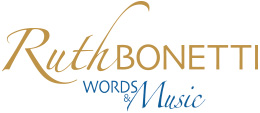Books for Musicians
Here are the tools to star performance!
Books, E-books & resources by Ruth Bonetti
For purchases within UK, Europe: Gazelle Book Services +44(0)1524 68765, Fax: +44(0)1524 63232, email.
Please note: the prices by default, are in Australian Dollars.
All books recently updated in new editions
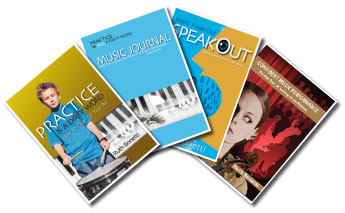
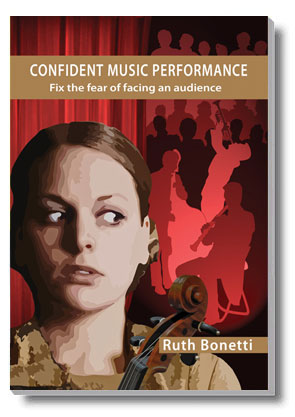
Confident Music Performance
You’ve practised hard, you have ability – but are you able to walk on stage and shine? This book will help you face the audience without fear, enjoy the moment and succeed.
Paperback – Words & Music Press, 2002 ISBN: 978-0-9578861-6-2
For purchases within UK, Europe: Gazelle Book Services +44(0)1524 68765, Fax: +44(0)1524 63232, email.
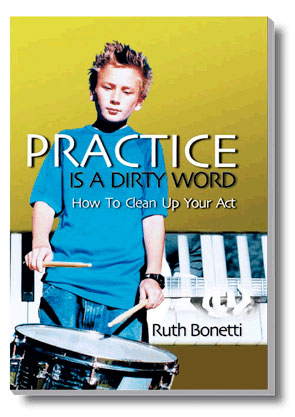
Practice Is A Dirty Word
How to Clean Up your Act
Ruth Bonetti
This newly revised book, Practice is a Dirty Word – How to Clean Up Your Act rescues teachers, parents and students alike from the bogey of practice. The book aims to help developing musicians to “work smart” so they can enjoy their playing and realise their potential.
Paperback – Words & Music Press, 2002 ISBN: 978-0-9578861-5-5
For purchases within UK, Europe: Gazelle Book Services +44(0)1524 68765, Fax: +44(0)1524 63232, email.

Posters
Resources to Empower Teachers and reinforce lesson input
MOTIVATIONAL POSTERS cement learning!
Visit the Store to browse posters and buying options
‘They make great lesson plans!’ –Miriam Townsley, Music Director, Mt St Michael College.
Other books by Ruth Bonetti
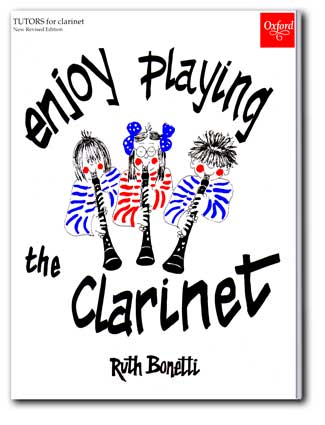
Enjoy Playing the Clarinet
INTERNATIONAL BEST SELLER (25,000 copies sold world wide!)
This is the book to have fun playing the clarinet!
Paperback – (1991)
Oxford University Press, ISBN 0 19322 108X
Piano Accompaniment book also available
Testimonials
“Excellent method, beautifully presented with helpful suggestions.” –I.S.M.E.
“One of the best tutors for young beginners, full of sound teaching ideas, attractive and challenging tunes.” – Paul Harvey
Ordering:
Please contact your local bookshop or OXFORD UNIVERSITY PRESS direct to purchase this book or the Piano accompaniment book
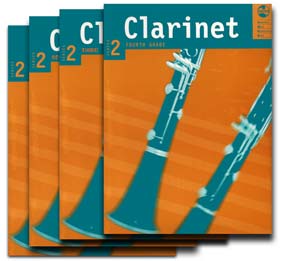
Clarinet Series 2
Australian Music Examination Board Syllabus, Grades 1–4
Pieces chosen and edited by Ruth Bonetti, Consulting Editor.
Ordering
Available from AMPD www.ampd.com.au
Reviews, Testimonials & Excerpts
Reviews
Ruth Bonetti’s book Practice is a Dirty Word is a manual for the developing music student or the frustrated music teacher. For any of us who have learnt an instrument or have children who are learning one, this book will certainly strike a chord (foolish pun intended). It approaches the whole subject of laborious practice with a certain wit and light-heartedness and is laced with jokes that diffuse our attempts to make excuses for our lack of practice. Very useful also are instructions on how to practice efficiently so that we can spend less time “practicing” and more time frolicking in the yard. Ultimately, this book is designed to exterminate the bogeyman of music practice forever from our minds, a bogeyman whose legacy has been scaring potential Beethovens away from the keys, frets, horns, and drums the world over.
Living Now, Reviewed by James Marples
Stimulating, thought provoking, and engagingly written by an experienced professional musician and music teacher, this small book takes a fresh approach to “doing your practice”. It provides logical reasons for practising, identifies goals, discusses methods to enliven scales and arpeggios practice, and outlines how to program the brain for maximum performance during exams, recitals, and competitions. Enhanced with humorous black and white drawings, and amusing asides and anecdotes, it also explores how to pick the right instrument for an individual to learn, and how to handle over-zealous parents. This is a highly recommended volume for music teachers, parents and music students. Highly recommended.
AccessEd
Have you done your practice?” is a question that many young music students dread. Practice to them is a bogy; a half hour or so of something they feel they should do without understanding how to do it. Making enough noise to keep the adults off their backs becomes the aim of the exercise. But if, as Ruth Bonetti suggests, we change the word ‘practice’ to ‘making music’ then it becomes a different ballgame. Suddenly there seems to be a reason for our practice and a different goal.
Ruth Bonetti talks to young musicians explaining how to practice intelligently so that not only do they enjoy their playing, but they get great results. She shows how to plan practice time and gives practical help on setting goals, fixing mistakes and weaknesses, jazzing up practice and, best of all, demystifying those dreaded scales and arpeggios. There’s a chapter on managing teachers and parents, another on choosing the right instrument and another with helpful hints for students facing exams, competitions or recitals.
This book is non-threatening and easy to read. The author is aiming at students, but the psychology behind her wise words would be helpful to many parents and teachers as well. Ruth Bonetti has inspired me. I’m off to make music.
Available from www.ruthbonetti.com
Good Reading Magazine
Reviewed by Emily Darling
The State Library of Queensland hosted the launch of a new book by Brisbane based musician, speaker and teacher, Ruth Bonetti. The new book, called Practice is a Dirty Word, is her fourth publication, following Enjoy Playing the Clarinet, Don’t Freak Out – Speak Out and Taking Centre Stage.
Renowned conductor of the Queensland Youth Symphony, John Curro officially launched the book. Mr Curro spoke highly of the book, which talks about making practice fun rather than a necessary and unpleasant chore for musicians and students.
Ruth Bonetti’s son, Paul wrote original music to be performed at the launch, including the track Practice is a Dirty Word. This young composer stretches the boundaries of traditional uses of instruments, harmony and rhythm as well as styles.
The book makes suggestions about how to have more fun during practice, techniques to make the practising of scales more relevant to the music and easier to understand, and peppered through the book for a bit of light relief are some common – and not so common – excuses for not practising (“Dad said I should know it all by now” or “My finger hurts, maybe I have arthritis.”)
Practice is a Dirty Word is not so much a new practice and performance technique, as much as a suggested guide to making music more fun. It was written to be reader-friendly even to young students, and contains many tips for teachers and parents.
Classical Music, Reviewed by Ralphine Harris
Taking the pain out of music lessons
Ruth Bonetti believes the old adage “practice makes perfect” is a myth. Not only is musical perfection unattainable, it would be deadly boring. A teacher for more than 30 years, Bonetti has written a book called Practice is a Dirty Word; How to clean up your act. It describes a number of “cures” for practice-shy young musicians. The book explains the importance of scales, how to set realistic goals, and how to fix mistakes, Bonetti, based in Brisbane, says it is more difficult to keep a child interested in music than in other activities, because of the amount of effort required to achieve results. “I know lots of people who wish they’d held in there a bit longer,” she says. The key was to help students enjoy their music lessons and show them how to use their time effectively.
ABC Radio 24 Hours
For any parent or teacher who has come even close to tearing their hair out when it comes to their child’s music practice, this book is a godsend!
Can you imagine never again having to nag your student to practice?
Ruth Bonetti’s book could be the end of all your woes!
Many otherwise keen young musicians are loathe to practice. With all of its usual connotations (drudgery and boredom), it is no wonder!
Most practice is time-oriented rather than being quality time. Have you done your half-hour? is the usual plea and often students resort to just making a noise to keep teachers and parents off their backs! The sad fact is that time is often spent repeating mistakes over and over which are then embedded into the technique.
The dictionary definition of the word ‘practice’ is ‘to do habitually’. Not perhaps the best or most inspiring description when applied to music!
Practice is a Dirty Word rescues you from the bogey of practice. It encourages the student to work smart and achieve results within a realistic time-frame.
Ruth explodes the myth that practice makes perfect and focuses instead on success at each level and age group. Intrinsic to her philosophy is that music-making should be enjoyable. Practice times can and should be fun. Look on this time as the opportunity to make beautiful sounds, enjoy the wonderful music of the great composers and explore the potential within you.
Unlike sports where the team spirit carries one forward it is often difficult to be motivated to work alone, so we need to think of the rewards and have long as well as short-term goals. In a concise 106 pages this book shows you how!
Ruth offers hundreds of tips for how to plan practice time, how to fix weak spots, enliven the dreaded scale work and ultimately, enjoy success at exams and recitals.
Music and its practice is a wondrous journey of exploration that teaches young people discipline, creativity and self-reliance along the way and enhances all other facets of their lives.
Ruth’s book is a ‘must-have’ for every budding musician, for every frustrated parent and for every jaded teacher!
Australian Music Teacher, Reviewed by Mary Nemet
Australian author and music educator, Ruth Bonetti has written another ‘gem’ of a book whose many facets sparkle with sensible and practical suggestions for the budding musician. Her engaging and humorous writing style and lively lay-out of the book, all serve to deliver vital information about the serious business of practice, in a user-friendly fashion.
Anyone who takes on the study of music will find that there are always physical and mental challenges to be met, before arriving at the level of ‘ultimate performance’.
Ruth presents strategies to cope with
- mistakes and problems
- finding time to fit practice in a busy daily schedule
- scale learning
- counting
- and many other aspects of learning.
She even suggests rewarding yourself with a jellybean!
The book deals with what all teachers know are classic ‘time-wasters’ and excuses: ‘ my baby sister ate my only saxophone reed! ‘. It also gives students information as to how to manage teachers and parents, and how to impress an examiner.
I particularly enjoyed the sections on how to ‘work smart’ to learn a new piece. Ruth and I have for many years thought along similar educative lines and she has encapsulated many of the teaching techniques that I too have found to be effective in the teaching and learning of a new piece. These include: recommending analysis of structures and patterns and presenting scales in graphic form, along similar lines to the patterns which appear in many of my own educational publications.
Finally, the book is published in A5 – a size that fits into the handbag easily, and is just the right length to allow you to read it and still have time to get back to practicing. I highly recommend it to both students and teachers. (PS – parents will like it too!)
The book is available from leading music stores or (autographed) from Ruth Bonetti, PO Box 422, The Gap Qld 4061 Australia
Margaret Brandman is an Australian composer and author of many Contemporary Teaching materials, including the high school text book ‘Accent on Music’, the Contemporary Piano Method and Pictorial Patterns for Keyboard Scales and Chords. For more information go to www.margaretbrandman.com
Music Teacher Magazine – Review by Margaret Brandman
Ruth Bonetti’s perceptive and positive approach will be beneficial to any musician.
Winds Magazine
Testimonials
For Enjoy Playing the Clarinet
Ruth Bonetti’s book Practice is a Dirty Word is a manual for the developing music student or the frustrated music teacher. For any of us who have learnt an instrument or have children who are learning one, this book will certainly strike a chord (foolish pun intended). It approaches the whole subject of laborious practice with a certain wit and light-heartedness and is laced with jokes that diffuse our
For Enjoy Playing the Clarinet
“Excellent method, beautifully presented with helpful suggestions.” –I.S.M.E.
“One of the best tutors for young beginners, full of sound teaching ideas, attractive and challenging tunes.” – Paul Harvey
“Thoroughly recommended…entertaining and fully justifies its title.” – Clarinet & Saxophone, UK
“A very alive tutor. I love her method of teaching the minor scales. Also her Mystery Melodies with which she teases the pupil.” – Pamela Weston, Music Teacher
‘…well presented and fully justifies its title…as a tutor for young players this book can be thoroughly recommended.’ – Peter Howes (Clarinet & Saxophone)
EXCERPT from Confident Music Performance:
Introduction
“You cannot be a musician without living with the hobgoblins and demons of insecurity,” advises Lynn Harrell, the American cellist and director of the Royal Academy of Music, London . “As you go through your career, have the courage to know that they are there. If you feel the raucous cackle of the crowd pushing in on you, then push it back and away and make the space in which to remember why you became a musician in the first place.
“Music is about man’s deepest feelings and aspirations. The irony is that as we get older we get more and more embarrassed about expressing that. Don’t be afraid of the nakedness – without it there is no expression.”
What a career hazard!
Most performers have been inhibited by nerves at some time or another; many top musicians have been paralysed by them at times, yet their creativity and reputation triumphed. Johannes Brahms was too inhibited to play before Franz Liszt; Ludwig van Beethoven despaired after a public fiasco; the wunderkind Felix Mendelssohn fled the room in tears when performing for Hummel.
Highly creative, sensitive performers often suffer the most from nerves, while matter-of-fact people may cope better. The very sensitivity that enriches exceptional performances often works against the artists instead of for them. Some of the greatest talents never realise their full potential because of nerves. Their vivid imaginations, capable of drawing out the sublime, can also predict numerous mishaps and stumbles, turning the minutes, hours, days or weeks before a performance into miseries of imaginings, many unlikely to eventuate.
We performers face exposure of vulnerable weaknesses, lack of ability, preparation or poise. Defensive thoughts swirl through our minds: all those upraised eyes are aimed at me. Surely my quivering knees and fingers are obvious. Trapped up here under these glaring, hot footlights, both physically and emotionally. Fight-or-flight are denied me. I am alienated, alone and exposed up on the bare boards of the stage, on trial, confronting my peers who sit cushioned in group anonymity.
I am afraid that people will discover just how little work I did. What will they think of me? My self-esteem has plummeted, for it seems my worth as a person hangs on that frayed thread of the brilliance of my presentation. A telescopic lens magnifies mistakes in my mind. The footlight laser beam impresses those mistakes indelibly in my memory.
To all of you who suffer from such agonies I say, take heart. You suffer because you are not a potato. Does a potato possess your abilities, your sensitivity or richness of imagination? Do you want to play like a potato? Do people pay to hear potatoes perform? Your creativity makes life harder, but it sets you apart.
The purpose of this book is to help you turn those negatives which may block you into positives which can allow your talent to blossom, your soul to soar. It will help you understand and anticipate, utilise and even welcome that rush of adrenaline which, when excessive, causes panic. However, when properly channelled, this adrenaline can lift a performance from the merely mundane to an exciting, enriching and communicating event. In this way performance tension is changed into vital energy.
As I listened to a talk on performance anxiety given by a psychiatrist at a music conference, I realised the need for a practical book to help people cope with their nerves. It seemed obvious from the listeners’ avid response and eager questions that many sought help for their anxiety and wanted to learn ways to a better performance. I found the scientific-medical aspect of the talk interesting, but related best to the few personal moments when the speaker discussed how he had faced his own nerves prior to the lecture. However, I was concerned that his main solution was medication: beta blockers. Surely there must be more natural, practical solutions?
I thought back to my own concerto performance a few days before and the props I had used to steel myself. A colleague had shared the backstage warm-up room, and out of the corner of my eye I noticed with interest her routine of preparation and relaxation. Did my own elaborate procedures help? Yes, to a large extent. Yet it was my attitude of mind that most influenced the outcome of the performance.
Ironically, even though I knew I could play a work that I had performed many times before, I was inhibited by wondering if the heavies of the profession were in the hall – only to discover later that they weren’t! I realised how often our communication with the audience is inhibited by such misconceptions.
Often we imagine criticism where none is intended. Even if it were, is it not better to play for ourselves and for the appreciative, rather than for those few who make an art-form of criticising? Often the loudest, most derisive voices belong to defensive, insecure rivals who try to make themselves bigger by knocking us down to size.
Soon after this concert, I spent a week travelling in country areas to examine music candidates. Every day I encountered several candidates, usually well motivated adults, whose nerves reduced them to quivering jelly. It was obvious they were keen and had prepared diligently. In spite of my tight schedule, I felt compelled to take time to help them cope with their nerves. This book was conceived during my return flight as I thought over their problems and how I had handled similar situations. Since we all experience our careers and communications differently I knew that my one voice could not find answers to such varied problems. We all tread our paths differently. I decided to offer a holistic approach, a smorgasbord of suggestions from which readers could nibble at will, according to their taste or need.
Performance encompasses the whole person, so it is necessary to offer a wide range of solutions – physical, mental, emotional and spiritual. All the people who populate this book are its life-blood. Whether a big-name or a suburban music teacher, they are real people, triumphing over real dragons. These flesh and blood and heart people, who may have risked vulnerability by being quoted, have courageously and openly shared their experiences in order to help others. I hope that the performing arts scene may seem a more understanding place as a result.
If others’ ideas have not been credited, this is because in the weft and warp of experience, one absorbs many ideas without knowing or remembering their source. Many are passed on by our modern version of folklore, teaching. I thank all those who have in many ways given insight, contributions, feedback, encouragement and support, who read or edited chapters.
Thank you, especially, to my husband, Antoni, who has been a constant sounding-board, for making suggestions from his own expertise as a violinist, conductor and educator, for his endurance through countless rewrites and for sharing with me so many enriching musical adventures.
The following chapters will fortify those facing public performance as well as their teachers and parents. This book seeks to encourage and empower all who communicate from centre-stage.
